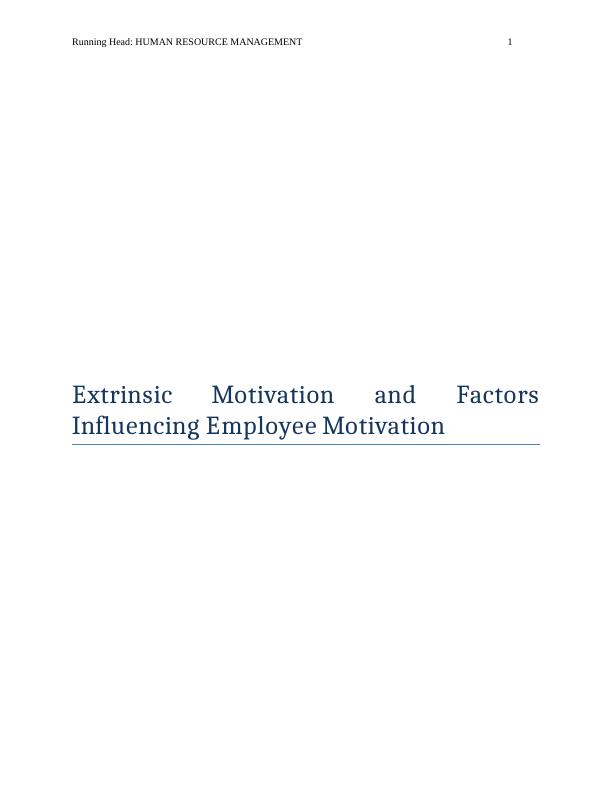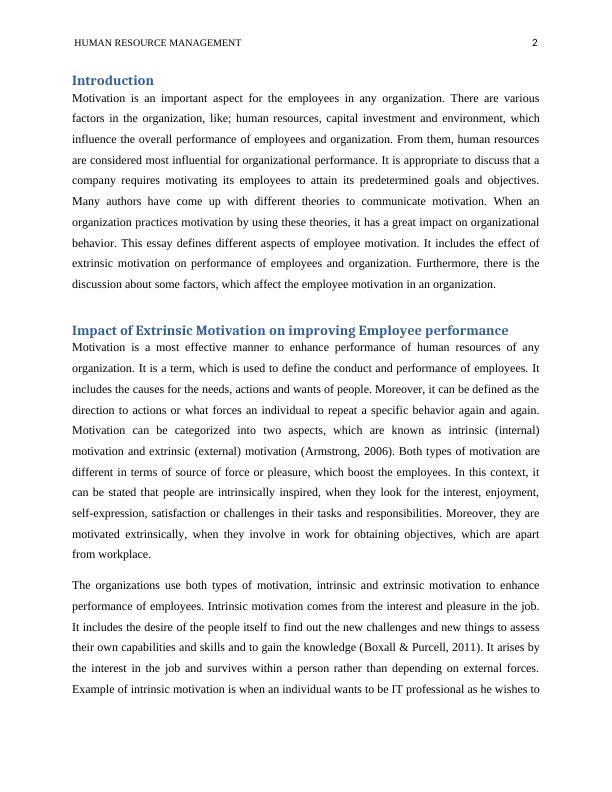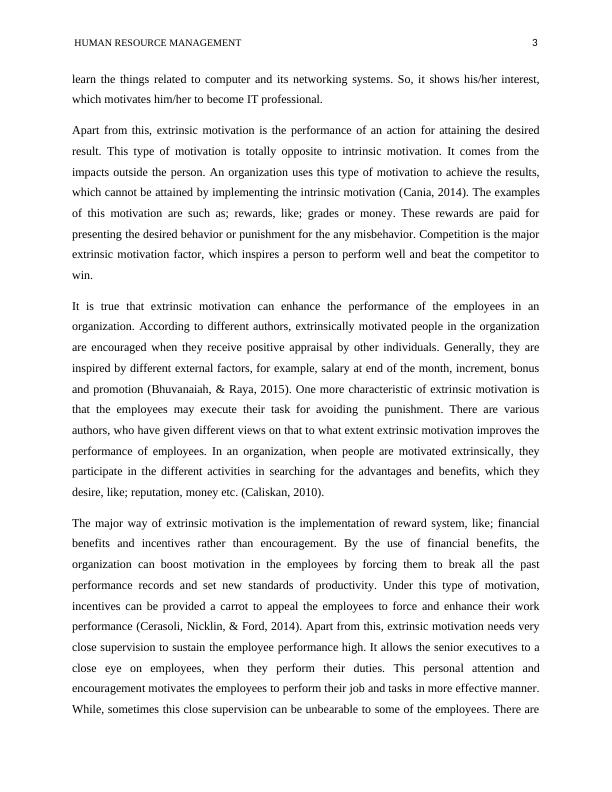Factors Influencing Employee Motivation
8 Pages2680 Words71 Views
Added on 2020-04-13
Factors Influencing Employee Motivation
Added on 2020-04-13
ShareRelated Documents
Running Head: HUMAN RESOURCE MANAGEMENT 1Extrinsic Motivation and FactorsInfluencing Employee Motivation

HUMAN RESOURCE MANAGEMENT2Introduction Motivation is an important aspect for the employees in any organization. There are variousfactors in the organization, like; human resources, capital investment and environment, whichinfluence the overall performance of employees and organization. From them, human resourcesare considered most influential for organizational performance. It is appropriate to discuss that acompany requires motivating its employees to attain its predetermined goals and objectives.Many authors have come up with different theories to communicate motivation. When anorganization practices motivation by using these theories, it has a great impact on organizationalbehavior. This essay defines different aspects of employee motivation. It includes the effect ofextrinsic motivation on performance of employees and organization. Furthermore, there is thediscussion about some factors, which affect the employee motivation in an organization. Impact of Extrinsic Motivation on improving Employee performance Motivation is a most effective manner to enhance performance of human resources of anyorganization. It is a term, which is used to define the conduct and performance of employees. Itincludes the causes for the needs, actions and wants of people. Moreover, it can be defined as thedirection to actions or what forces an individual to repeat a specific behavior again and again.Motivation can be categorized into two aspects, which are known as intrinsic (internal)motivation and extrinsic (external) motivation (Armstrong, 2006). Both types of motivation aredifferent in terms of source of force or pleasure, which boost the employees. In this context, itcan be stated that people are intrinsically inspired, when they look for the interest, enjoyment,self-expression, satisfaction or challenges in their tasks and responsibilities. Moreover, they aremotivated extrinsically, when they involve in work for obtaining objectives, which are apartfrom workplace. The organizations use both types of motivation, intrinsic and extrinsic motivation to enhanceperformance of employees. Intrinsic motivation comes from the interest and pleasure in the job.It includes the desire of the people itself to find out the new challenges and new things to assesstheir own capabilities and skills and to gain the knowledge (Boxall & Purcell, 2011). It arises bythe interest in the job and survives within a person rather than depending on external forces.Example of intrinsic motivation is when an individual wants to be IT professional as he wishes to

HUMAN RESOURCE MANAGEMENT3learn the things related to computer and its networking systems. So, it shows his/her interest,which motivates him/her to become IT professional. Apart from this, extrinsic motivation is the performance of an action for attaining the desiredresult. This type of motivation is totally opposite to intrinsic motivation. It comes from theimpacts outside the person. An organization uses this type of motivation to achieve the results,which cannot be attained by implementing the intrinsic motivation (Cania, 2014). The examplesof this motivation are such as; rewards, like; grades or money. These rewards are paid forpresenting the desired behavior or punishment for the any misbehavior. Competition is the majorextrinsic motivation factor, which inspires a person to perform well and beat the competitor towin. It is true that extrinsic motivation can enhance the performance of the employees in anorganization. According to different authors, extrinsically motivated people in the organizationare encouraged when they receive positive appraisal by other individuals. Generally, they areinspired by different external factors, for example, salary at end of the month, increment, bonusand promotion (Bhuvanaiah, & Raya, 2015). One more characteristic of extrinsic motivation isthat the employees may execute their task for avoiding the punishment. There are variousauthors, who have given different views on that to what extent extrinsic motivation improves theperformance of employees. In an organization, when people are motivated extrinsically, theyparticipate in the different activities in searching for the advantages and benefits, which theydesire, like; reputation, money etc. (Caliskan, 2010). The major way of extrinsic motivation is the implementation of reward system, like; financialbenefits and incentives rather than encouragement. By the use of financial benefits, theorganization can boost motivation in the employees by forcing them to break all the pastperformance records and set new standards of productivity. Under this type of motivation,incentives can be provided a carrot to appeal the employees to force and enhance their workperformance (Cerasoli, Nicklin, & Ford, 2014). Apart from this, extrinsic motivation needs veryclose supervision to sustain the employee performance high. It allows the senior executives to aclose eye on employees, when they perform their duties. This personal attention andencouragement motivates the employees to perform their job and tasks in more effective manner.While, sometimes this close supervision can be unbearable to some of the employees. There are

End of preview
Want to access all the pages? Upload your documents or become a member.
Related Documents
EHR205 Organisational Behaviourlg...
|12
|2948
|174
Organisational Behavior: Difference between Extrinsic and Intrinsic Motivationlg...
|11
|2696
|91
Assignment | Intrinsically Motivated Vs Extrinsically Motivatedlg...
|3
|1079
|315
Leadership and Organizational Behavior: Motivation and Organizational Commitmentlg...
|6
|1334
|380
Understanding Why People Worklg...
|10
|2201
|102
Understanding Why People Work and What Motivates Them: A Study on Positive and Negative Factors Experienced by Employeeslg...
|8
|2085
|85
